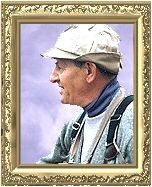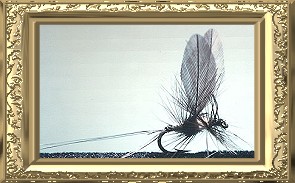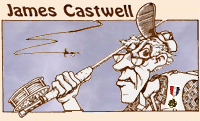|
I had a phone call this morning from a fellow in
Texas, they are doing a program on the late Vince
Marinaro and his flies. It brought back some nice
memories, we talked for quite a while. Vince was
an old friend of mine and I learned a lot from and
with him. We tied together, examined stream stuff,
fished together, took pictures, compared notes on
many subjects; we corresponded by audio-tape and
letter and phone when he was back home and I was
in Michigan.

This morning I found myself once again delivering
almost a sermon on the whole set of circumstances
that are generated by using his flies. There is a
lot to it you know. Many think that the only thing
is a funny looking fly that seems too tough to tie
and not worth the effort to learn. They do not look
like other dry flies so they must not be quite as good,
if any good at all. Nothing could be further from
the truth.
Let my, briefly, try to give you a snapshot of how it
works. Use a 'real' Thorax dry fly and because it sits
on the surface like a natural, the foot-print seen from
below by the fish convinces the fish to take the fly gently,
just like he takes a real bug. No big slashing splash,
just a tip and sip. Because of the gentle take you can
use one size lighter tippet. That also gives you a better
presentation and a more drag-free drift. All of that gives
you an increase in the amount of acceptances rather than
refusals. Rolled all together they greatly increase your
overall percentage of risen and hooked fish. As you can
see, there are a whole lot of things that improve by
simply changing to a fly which truly represents a natural
insect.
 Remember when you tie the dun, that the tails should be
out-rigger style to keep the fly from tipping over, and
take two turns of hackle to the front and back around a
thorax-ball that is big enough to hold the hackle firmly.
I like to use rabbit fur for that, it is soft enough
to compress and holds well. Use good enough hackle so
the tips are strong enough when slanted like that and
they support the fly above the surface.
Remember when you tie the dun, that the tails should be
out-rigger style to keep the fly from tipping over, and
take two turns of hackle to the front and back around a
thorax-ball that is big enough to hold the hackle firmly.
I like to use rabbit fur for that, it is soft enough
to compress and holds well. Use good enough hackle so
the tips are strong enough when slanted like that and
they support the fly above the surface.
And on the spinner, do not make the tails out-rigger,
but in line with the body. Cock the wings a little so
that one will flop down and leave the other up enough
so if a breeze comes along it may cause the fly to
rock on the surface a bit. The fly should roll on
the body-tail combination.
The style can be used on most any mayfly imitation
although I only use it on flies size ten and smaller.
There is no substitute for the style. The method of
clipping the hackle from the bottom of a front hackled
standard fly is ludicrous and the result is only a
bastardization of a fine technique and those who do
so should be ashamed to even use the name Thorax for
any reason.
When we were guiding for Dan Baily's we taught his
tying-girls the true Thorax flies and they were even
available on the front counter, this was back in the
early '70's. I have not seen any real ones for sale
since. They will not do much for your fly-fishing if
you can't present a fly right or mend a drift, but if
you have progressed and have some degree of finesse on
the stream they may add a new dimension to your
enjoyment.
Remember, these flies were designed right from the start
to be a dry fly and to ride and float like a natural.
The wings and hackle are in the center of the hook.
Today's standard dry's are simply re-designed wet
flies using feathers that may make them float, hence
the hackle at the front of the fly as in a wet fly.
They will take a fish at times, but mostly as an
attractor.
~ James Castwell
|



